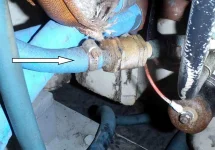bobk
Legendary Member
- Joined
- Aug 27, 2005
- Messages
- 4,097
- Status
- OWNER - I own a Hatteras Yacht
- Hatteras Model
- 48' MOTOR YACHT-Series I (1981 - 1984)
I just noticed that the turbos on my 6V92 TA's (425 HP) have what look like check valves on the drain lines. Do these need regular service like those on the air box drains?
Bobk
1981 48MY
Chateau de Mer
Bobk
1981 48MY
Chateau de Mer


